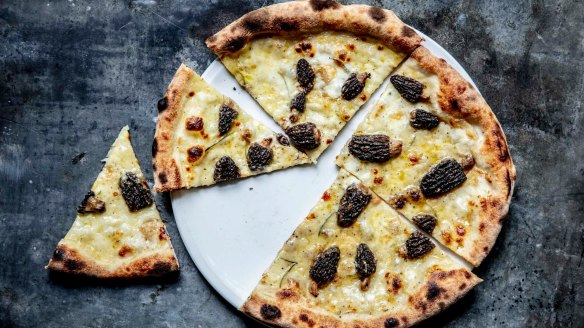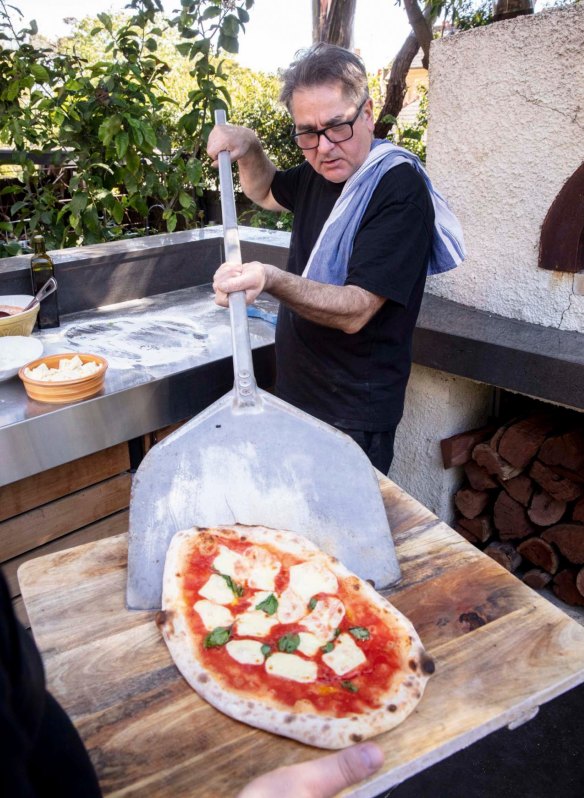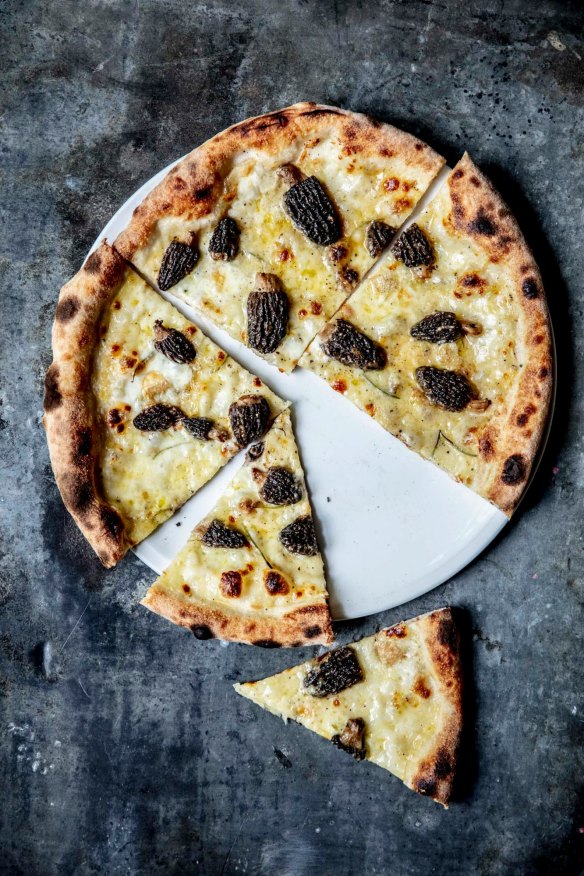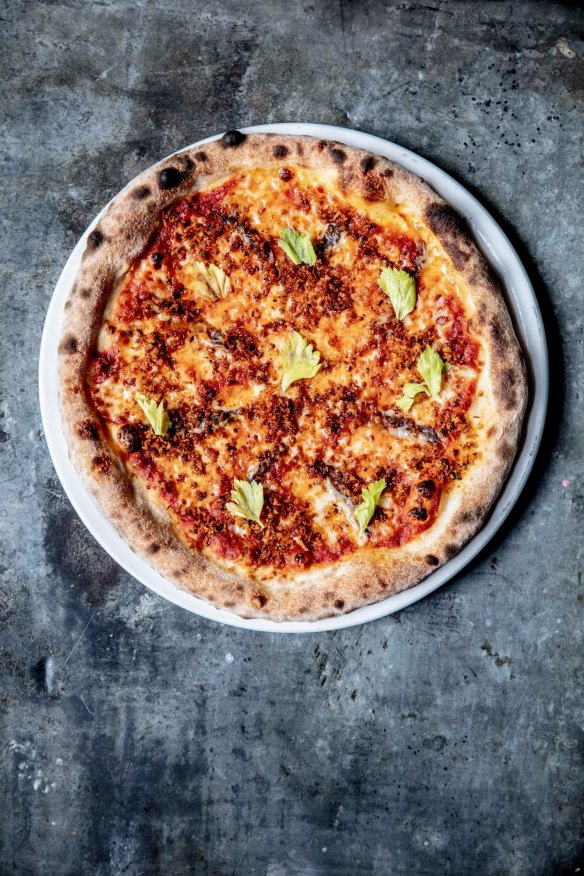Simple pizza recipes from Melbourne's Ombra (plus how to make 'nduja)

Carlo Grossi, of Melbourne's Ombra restaurant, shares dough and topping recipes from his cookbook of the same name, plus his top tips for your next pizza party.

Ombra pizza dough
When we were opening Ombra, there was no question that we had to have pizza as part of our story. It was important that we had the right style of dough to form the base of all our pizzas. We wanted more of a Roman style of pizza, a lighter, crisper end result than the softer Neapolitan-style base that tends to droop in your hands!
Cooking pizza at home is like making pasta: it's tactile. Once you start rolling it out everyone starts to get involved, getting their hands into the dough and making all sorts of shapes and rustic-looking bases. It really brings people together, and the satisfaction of making something together that you'll then eat as a group is a truly fulfilling feeling.
INGREDIENTS
- 8g fresh yeast, crumbled, or 2 tbsp dried yeast
- 1 litre water
- 1.6kg good-quality strong pizza flour
- 2 tbsp salt
METHOD
- Dissolve the yeast in 250ml (1 cup) of the water in the bowl of an electric mixer fitted with a dough hook. Add the flour, salt and remaining 750 ml (3 cups) water and mix on low speed until combined, then increase the speed slightly and mix for 10-15 minutes or until the dough is smooth and elastic.
- Transfer the dough to a container, cover and leave it in the fridge for 24 hours.
- The next day remove the dough from the fridge, then cut it into 10 × 250g pieces. Roll into balls and leave them on a floured tray, covered with a clean tea towel, to prove for another 24 hours in the fridge. The next day the dough will be ready to use.
Makes 10 10 pizzas
Pizza margherita

When it comes to toppings, we like to stick to the adage "less is more". A few very well assembled ingredients really shine on pizza – once you heap on more than the base can handle, things start to lose their authenticity. Pizza is about balance. (Carlo's father Guy Grossi pictured right.)
INGREDIENTS
- semolina flour, for dusting
- 250g pizza dough (see recipe above)
- 80g San Marzano tinned tomatoes, blended
- 80g fior di latte, torn into small pieces
- 7 basil leaves
- olive oil, for drizzling
METHOD
- Preheat the oven to 220C fan-forced (240C conventional). Lightly oil a large pizza tray or preheat a pizza stone.
- Lightly dust the workbench with semolina flour. Stretch the pizza dough with your hands, ensuring the edge remains thick enough to form a crust. Start by pushing your fingertips into the dough to make it flat and round, keeping the thickness around the edge. Then stretch the dough, using one hand to hold it while the other gently stretches the edge, moving around the circumference.
- Transfer the dough to the prepared tray or onto the preheated pizza stone using a paddle. Spread the tomato puree over the dough with the back of a spoon, then scatter with the cheese and basil. Drizzle with a little olive oil and bake for 5-7 minutes or until crisp and golden.
Makes 1 pizza
Pizza fungi, fontina

There's such a particular joy in seeing the first-season autumn mushrooms coming into the restaurant calling out to be used on a pizza. Their earthy, fungal fragrance goes extremely well with the pungent northern Italian fontina cheese. This pizza is rich and delicious.
INGREDIENTS
- semolina flour, for dusting
- 250g pizza dough (see recipe above)
- 90g fior di latte
- 50g seasonal mushrooms (see below)
- 30g fontina, sliced
- olive oil, for drizzling
Seasonal mushrooms
- 100ml olive oil
- 30g unsalted butter
- 300g mushrooms (such as pines, morels or porcini), cleaned and cut into 5mm slices
- 2 cloves garlic, finely chopped
- 1 tbsp chopped rosemary
- 1 tbsp finely chopped sage
METHOD
- To prepare the mushrooms, heat the olive oil and butter in a large frying pan over medium heat. Add the mushrooms and saute until they start to colour. Add the garlic and herbs and cook for a further 5 minutes or until the mushrooms have softened and any liquid has evaporated. Remove from the heat and allow to cool. Store any leftover mushrooms in an airtight container for up to 2 days.
- Preheat the oven to 220C fan-forced (240C conventional). Lightly oil a large pizza tray or preheat a pizza stone.
- Stretch the pizza dough using your hands, ensuring the edge is thick enough to form a crust. Transfer the dough to the prepared tray or the preheated pizza stone using a paddle.
- Scatter the fior di latte over the dough, followed by the mushrooms and fontina. Drizzle with olive oil. Bake for 5-7 minutes until crisp and golden.
Makes 1 pizza
Pizza 'nduja

'Nduja is the fiery salumi from Calabria, rich both in spice and fat. It's great as a spread on crusty bread as a cicchetti (snack) but it also finds its home beautifully on this pared-back pizza with fior di latte and the delicious saltiness of anchovy fillets.
INGREDIENTS
- semolina flour, for dusting
- 250g pizza dough (see recipe above)
- 40g 'nduja sauce (recipe below)
- 90g fior di latte, torn into small pieces
- 7 anchovy fillets
- ¼ cup parmigiano crumb (recipe below)
- celery leaves, to serve
Parmigiano crumb
- 100g grated parmigiano
- 2 tbsp olive oil
- 50g unsalted butter
- 100g panko breadcrumbs
- 3 tsp chopped flat-leaf parsley
- finely grated zest of 1 lemon
'Nduja sauce
- 1 tbsp olive oil
- 50g 'nduja (see recipe below)
- 100ml white wine
- 100g San Marzano tinned tomatoes, blended
METHOD
- Preheat the oven to 160C fan-forced (180C conventional). Line a baking tray with baking paper.
- To make the parmigiano crumb, spread the grated parmigiano over the prepared tray and bake for about 10 minutes or until golden brown. Remove from the oven and set aside to cool.
- Increase the oven to 220C fan-forced (240C conventional). Lightly oil a large pizza tray or preheat a pizza stone.
- Meanwhile, heat the oil and butter in a frying pan over medium heat, then add the breadcrumbs and cook for about 10 minutes, stirring often, until golden brown. Remove from the heat and set aside to cool. Crush the cooled parmigiano with your hands and mix in a bowl with the cooled breadcrumbs, parsley and zest. Store any leftovers in an airtight container for up to 1 week.
- To make the 'nduja sauce, heat the olive oil in a small saucepan over medium heat, then add the 'nduja and cook slowly until it starts to melt. Deglaze the pan with the white wine and add the tomatoes. Cook on a low heat for 5-6 minutes or until slightly thickened. Transfer to a bowl and allow to cool completely. Store any leftovers in an airtight container in the fridge for up to 2 days.
- Lightly dust the workbench with semolina flour. Stretch the pizza dough using your hands, ensuring the edge is thick enough to form a crust. Transfer the dough to the prepared tray or onto the preheated pizza stone using a paddle. Spread the 'nduja sauce over the dough with the back of a spoon, then scatter with the fior di latte and anchovies. Bake for 5-7 minutes or until crisp and golden. Serve sprinkled with the parmigiano crumb and celery leaves.
Makes 1 pizza
'Nduja
'Nduja is a type of spreadable sausage that comes from Calabria. It is high in fat and is always extremely spicy. The pork meat used is generally shoulder or belly. We love using 'nduja as part of a pizza topping or even stirred through pasta, and it is equally delicious on a crostini or piece of ciabatta as an aperitivo. It can be used in small quantities and will still pack a punch. I think I need a glass of soave just thinking about it!
INGREDIENTS
- 2.4kg pork fat
- 1 × 1kg piece pork shoulder, boneless and skinless
- 250g paprika
- 75g salt
- 40g dried chilli flakes
- 1½ tbsp cracked black pepper
- 6 cloves garlic, crushed
- ½ tsp curing salt (sodium nitrate)*
- 140ml red wine
- 140ml white wine
- 2 sheep bungs (natural sausage casings)*
METHOD
- Cut the pork fat and shoulder into 1cm pieces and place in a large bowl. Add the remaining ingredients, except the casings, and mix well. Cover and leave to marinate overnight in the fridge.
- Mince the pork mixture through the coarse mincing plate of a meat mincer into a bowl (ensure the pork mixture is very cold). Then mince the mixture again through the medium (8mm) mincing plate. Mix well and refrigerate again for about 2 hours until chilled.
- Place the casings in warm water for 5 minutes to soften. Flush the casings with cold running water. Attach the sausage-making nozzle to a sausage-making machine or a meat mincer with the blade and mincing plate removed. Gather a casing over the nozzle and tie off the end with a double knot, then fill slowly and firmly with the pork mixture, taking care to remove any air bubbles. Tie off the casing to seal the end, then repeat with the remaining casing and filling.
- Store in the fridge, wrapped in baking paper and plastic film, for up to 2 weeks.
*Curing salt (sodium nitrate) and sheep bungs (natural sausage casings) are available from butchers or online.
Makes 2 × 1.5kg sausages
This is an edited extract from Ombra by Carlo Grossi, photography by Mark Chew, published by Penguin Random House, RRP $39.99.
Appears in these collections
From our partners
Original URL: https://www.smh.com.au/goodfood/simple-pizza-recipes-from-melbournes-ombra-plus-how-to-make-nduja-20210330-h1uwvt.html